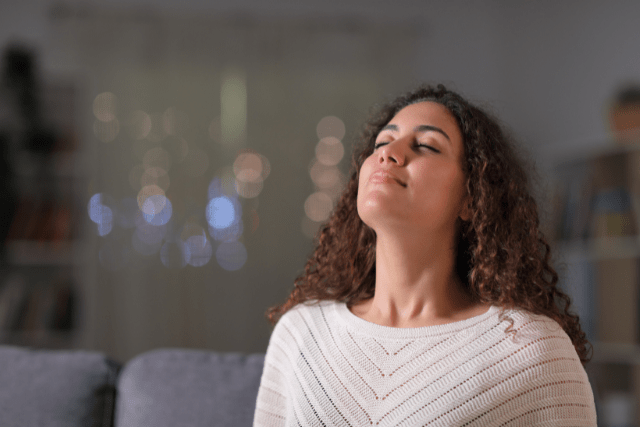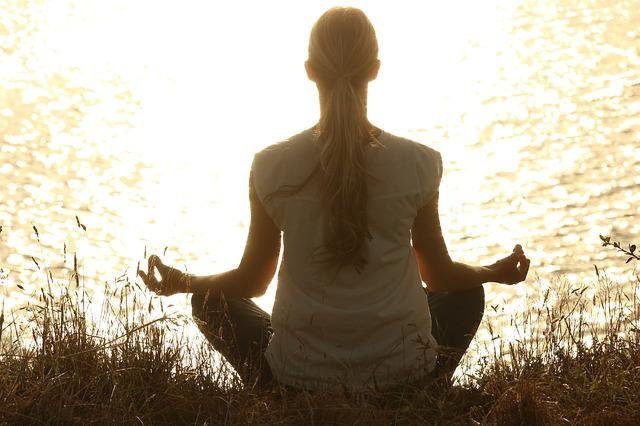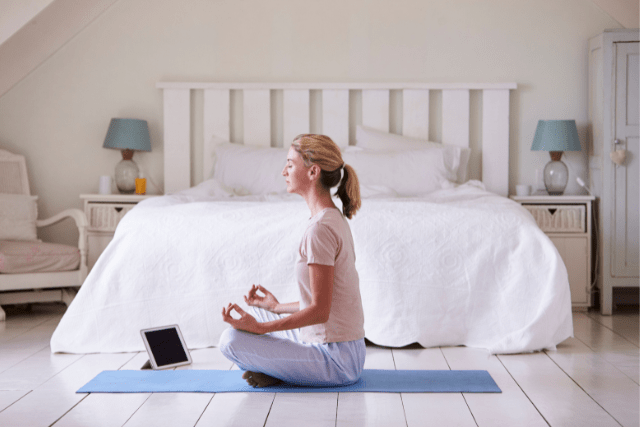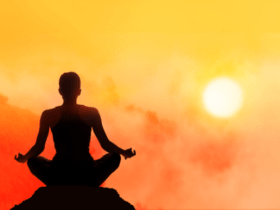In our fast-paced, stress-inducing world, finding moments of peace and calm can feel like an elusive dream.
But what if I told you that there is a simple practice that can help you find serenity amidst the chaos?
Meditation, a time-tested technique, has been proven to be an effective tool for reducing anxiety and promoting overall well-being.
Whether you’re a beginner or have dabbled in meditation before, this discussion will provide valuable tips and techniques to unlock the power of meditation and bring tranquillity into your life.
So, if you’re ready to embark on a journey towards a calmer mind and a more peaceful existence, let’s explore the world of effective meditation for anxiety reduction together.
Key Takeaways
- Mindfulness is a fundamental principle of meditation for anxiety reduction.
- Deep breathing techniques, such as deep belly and alternate nostril breathing, can help alleviate anxiety and promote relaxation.
- Visualization is a technique in meditation that can shift focus away from anxious thoughts and bring about serenity.
- Regular meditation practice can quiet the mind, manage stress, and alleviate anxiety.
Understanding the Basics
To get started with understanding the basics of meditation for anxiety reduction, it’s important to grasp the fundamental principles and techniques that form the foundation of this transformative practice.
Meditation is a powerful tool that can help you find calmness and inner peace amidst the chaos of daily life.
One of the fundamental principles of meditation is mindfulness. Mindfulness involves paying attention to the present moment without judgment. It helps you become aware of your thoughts, emotions, and physical sensations, allowing you to observe them without getting caught up in them.
This awareness can help you cultivate a sense of detachment from anxious thoughts and feelings, allowing them to pass by without getting overwhelmed.
Another technique commonly used in meditation is deep breathing. Focusing on your breath can anchor you in the present moment and alleviate anxiety. Take slow, deep breaths, inhaling through your nose and exhaling through your mouth.
Notice the sensation of the breath entering and leaving your body. As you do this, you may notice a sense of relaxation and calmness washing over you.
In addition to mindfulness and deep breathing, visualization is another technique that can help reduce anxiety. Close your eyes and imagine yourself in a peaceful, serene setting. It could be a beautiful beach, a tranquil forest, or a peaceful garden.
Allow yourself to fully immerse in this visual imagery, noticing the colours, sounds, and sensations. This visualization can help shift your focus away from anxious thoughts and create a sense of serenity and tranquillity.
Finding the Right Environment
Now that you understand the basics of meditation for anxiety reduction let’s explore the importance of finding the right environment for your practice.
Creating a conducive environment for meditation is essential to enhance your experience and achieve a deeper state of relaxation and liberation from anxiety.
First and foremost, find a quiet space to be free from distractions. This could be a spare room in your home, a peaceful corner in your garden, or even a secluded natural spot. The key is to choose a place where you feel calm and at ease.
Next, consider the lighting in your chosen environment. Soft, natural light is ideal, as it helps create a serene atmosphere. If possible, dim the lights or use candles to create a soothing ambience.
Another important factor to consider is the temperature. Ensure that the room or area is neither too hot nor too cold, as extreme temperatures can distract and hinder your ability to focus.
Lastly, make sure you are comfortable. Find a cushion or chair that supports your posture and allows you to sit for an extended period without discomfort. Wear loose, comfortable clothing that allows easy movement and does not restrict your breathing.
Breathing Techniques for Relaxation
Ready to take your relaxation to the next level? Discover the power of deep belly breathing, alternate nostril breathing, and box breathing.
These three breathing techniques can help you calm your mind, reduce anxiety, and promote deep relaxation.
Deep Belly Breathing
Take a deep breath, allowing your belly to expand, as you engage in the soothing practice of deep belly breathing for ultimate relaxation. Deep belly breathing is a simple yet powerful technique that can help you release tension, reduce anxiety, and promote a sense of calmness.
Here’s how to do it:
- Find a comfortable position: Sit or lie in a quiet, peaceful space where you can fully focus on your breath.
- Place your hand on your belly: Rest on your abdomen below your ribcage.
- Breathe deeply: Inhale slowly through your nose, letting the air fill your belly. Feel your hand rise as your abdomen expands. Exhale slowly through your mouth, allowing your belly to fall. Repeat this process, focusing on the sensation of your breath and the rise and fall of your belly.

Alternate Nostril Breathing
As you continue your journey towards anxiety reduction through deep belly breathing, let’s now explore the practice of alternate nostril breathing, a powerful breathing technique for relaxation.
Alternate nostril breathing, also known as Nadi Shodhana, is a simple yet effective way to calm your mind and balance your energy. To begin, sit comfortably with your spine straight and eyes closed. Using your right hand, bring your right thumb to your right nostril and close it gently.
Inhale deeply through your left nostril, then close it with your ring finger. Open your right nostril and exhale fully. Inhale through your right nostril, close it, and exhale through your left nostril.
Repeat this cycle for a few minutes, focusing on your breath and allowing yourself to experience a sense of tranquillity and inner peace.
Alternate nostril breathing can help release tension, reduce anxiety, and promote deep relaxation. Give it a try and feel the soothing effects for yourself.
Box Breathing
To enhance your relaxation and find a sense of calm, explore the powerful breathing technique known as box breathing. This technique involves breathing in a controlled manner, focusing on the length and depth of each breath.
- Find a comfortable position: Sit or lie in a quiet, peaceful space where you won’t be disturbed.
- Inhale slowly through your nose. Take a deep breath, counting to four, as you fill your lungs with air.
- Hold your breath: Once you’ve reached the count of four, hold your breath for another count of four.
- Exhale slowly through your mouth: Release the breath slowly, counting to four as you empty your lungs.
- Repeat the cycle: Continue this pattern of inhaling, holding, and exhaling for several minutes, focusing on the rhythm and sensation of your breath.
Box breathing can help you relax, reduce anxiety, and restore your mind and body balance. Practice this technique regularly to experience its transformative effects.
Guided Meditation for Anxiety Relief
If you’re looking for an effective way to reduce anxiety, consider trying guided meditation. Guided meditation is a technique where you listen to a recorded voice or follow along with a meditation app that provides instructions and guidance throughout the practice.
This type of meditation is particularly helpful for those who find it difficult to meditate on their own or are new to the practice.
Guided meditation for anxiety relief can be a powerful tool in calming your mind and releasing stress. The guided instructions help you focus your attention and guide your thoughts towards positivity and relaxation.
They often incorporate techniques like deep breathing, progressive muscle relaxation, and visualization to help you let go of anxious thoughts and find inner peace.
One of the benefits of guided meditation is that it provides structure and support, making it easier for you to stay present and focused. The voice guiding you helps to anchor your attention and prevents your mind from wandering off into anxious thoughts.
It can also be a great way to learn meditation techniques and explore what works best.
To get started with guided meditation, find a quiet and comfortable space to relax without distractions. Choose a guided meditation that specifically targets anxiety relief, and make sure to follow the instructions and guidance provided.
With regular practice, you’ll find that guided meditation can be a powerful tool in managing and reducing anxiety.
Incorporating Mindfulness Into Your Practice
With guided meditation serving as a foundation for anxiety relief, incorporating mindfulness into your practice can further enhance your ability to manage and reduce anxiety. Mindfulness is bringing your attention to the present moment without judgment.
Three ways to incorporate mindfulness into your meditation practice:
- Start with the breath: Begin your meditation by focusing on your breath. Notice the sensation of the breath as it enters and leaves your body. Whenever your mind wanders, gently bring your attention back to the breath. Focusing on the breath can help anchor you in the present moment and reduce anxious thoughts.
- Observe your thoughts and emotions: As you meditate, observe any thoughts or emotions that arise without getting caught up in them. Instead of judging or analyzing these thoughts, acknowledge them and let them go. This way, you can create space between yourself and your anxious thoughts, allowing them to lose power over you.
- Cultivate gratitude and compassion: During your meditation, take a moment to reflect on the things you are grateful for in your life. This can help shift your focus from anxiety to appreciation and bring a sense of calm and positivity. Additionally, cultivate compassion towards yourself and others. By practising kindness and understanding, you can create a more compassionate and peaceful inner environment, reducing anxiety.

Overcoming Common Meditation Challenges
One common challenge many people face when practising meditation is maintaining focus and avoiding distractions. It can be difficult to quiet the mind and keep it from wandering during meditation. However, there are strategies you can employ to overcome this challenge and deepen your practice.
First, finding a quiet and comfortable space for your meditation can help minimize distractions. Choose a location where you feel relaxed and can easily concentrate. You can also use earplugs or calming music to block out external noise.
Another effective technique is to set a specific intention for your meditation session. Focusing on a specific goal or purpose can anchor your attention and prevent your mind from drifting. This intention could be as simple as focusing on your breath or cultivating gratitude.
Using guided meditation apps or recordings can be helpful, especially for beginners. These resources provide step-by-step instructions and gentle reminders to stay present and focused.
Establishing a Consistent Meditation Routine
Are you ready to reap the benefits of daily meditation? Establishing a consistent meditation routine is key to experiencing the positive effects it can have on your anxiety. You can stay motivated and focused on your practice by setting meditation goals.
And don’t worry; we’ll help you overcome any obstacles that may arise along the way.
Daily Meditation Benefits
Establishing a consistent meditation routine can offer numerous daily benefits for reducing anxiety. By incorporating meditation into your daily life, you can experience the following benefits:
- Reduced stress: Daily meditation helps you relax and let go of the worries and tensions accumulated throughout the day. It allows you to find a sense of calm and peace within yourself.
- Enhanced focus and productivity: Regular meditation practice improves your ability to concentrate and stay present. This heightened focus translates into increased productivity in your work and daily tasks.
- Improved emotional well-being: Meditation helps cultivate a positive mindset, reduce negative emotions, and increase self-awareness. It allows you to respond to challenging situations with greater clarity and equanimity.

Setting Meditation Goals
To create a consistent meditation routine and achieve your goals, setting clear intentions and establishing a dedicated practice is essential. Setting meditation goals helps you stay focused and motivated on your journey towards inner peace and liberation from anxiety.
Start by identifying what you hope to achieve through meditation. Is it to reduce stress, improve mental clarity, or cultivate a sense of calm? Once you have a clear intention, commit to a regular practice.
Set aside a specific time and place for meditation, making it a non-negotiable part of your daily routine. Consistency is key. Start with a few minutes each day and gradually increase the duration as you become more comfortable.
By setting meditation goals and establishing a consistent routine, you create the space and commitment needed to experience the transformative benefits of meditation.
Overcoming Meditation Obstacles
When establishing a consistent meditation routine, overcoming obstacles is crucial for success. It’s natural to encounter challenges along the way, but with determination and the right strategies, you can overcome them and maintain a regular meditation practice.
Effective ways to overcome meditation obstacles:
- Find a dedicated space: Create a designated area in your home where you can meditate without distractions. A serene and peaceful environment will help you focus and make it easier to establish a routine.
- Set a schedule: Decide a specific time for your meditation practice each day. Consistency is key, whether early in the morning or before bed. By setting a regular schedule, you’ll be more likely to stick to it and make meditation a habit.
- Start small and build up: If you’re finding it hard to meditate for long periods, start with just a few minutes and gradually increase the duration. This will help you build your concentration and make meditation more manageable.
Conclusion
Incorporating meditation into your daily routine can be an effective tool for reducing anxiety. You can achieve a sense of relaxation and relief by understanding the basics, finding the right environment, and practising breathing techniques.
Guided meditation and mindfulness can further enhance the benefits of your practice. Although there may be challenges, establishing a consistent meditation routine will ultimately help you find inner peace and tranquillity.
So take a deep breath, find your calm, and start reaping the benefits of meditation today.
















Leave a Reply